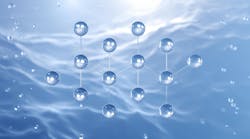According to new data from Beverage Marketing Corp., volume swelled to more than 5.4 billion gallons, an increase of 10.6% over 2000--significantly higher than in 2000 but slightly behind the growth recorded in 1999. Wholesale dollars increased even more dramatically, advancing by 11.5% to nearly $6.5 billion in 2001. One year earlier, sales grew by 9.3%, down from 13.9% in 1999.
Since the mid-1990s, producers' revenues have consistently increased more quickly than gallonage, reflecting the particularly strong showing of the retail PET segment comprised of water in 1.5-liter and smaller clear plastic bottles. High-margin single-serve packages have enjoyed exceptionally high growth, maintaining solid double-digit rates over the course of a decade. The segment's share of the bottled water market has increased from less than one-tenth in the early 1990s to approximately one-third of total volume in 2001, when volume enlarged by 30%. Michael Bellas, Beverage Marketing's chairman, has dubbed PET water "the perfect beverage category" because of its unparalleled performance.
Per capita consumption of bottled water has been growing by about one gallon annually - more than doubling in a decade. In 1991, the U.S. absorbed the equivalent of 9.3 gallons for each resident. By 2001, per capita bottled water consumption approached 20 gallons.
Perrier Group of America (PGA) and Danone Waters of North America (DWNA) stand as the largest bottled water purveyors in the U.S. However, attracted by the relentless growth of the market, the top soft drink manufacturers have entered the bottled water business with full force, presenting competitive challenges to the perennial industry leaders.
In 2001, PGA's wholesale dollar sales increased by 23.5%, surpassing $2 billion. Its sales have more than double over the course of five years. Its share of U.S. bottled water sales increased from roughly one-quarter in 1996 to nearly one-third by 2001.
While DWNA's growth slowed considerably in 2001, its sales of nearly $880 million were sufficient for it to retain its number-two position. While its 13.6% share of sales stood significantly higher than it was five years earlier, it was a notable decline from 2000, when it claimed a 14.7% market share.
Pepsi-Cola and Coca-Cola have become the third and fourth largest bottled water companies, respectively, when measured by dollar sales. Pepsi and Coke have gone from owning no U.S. bottled water brands just a few years ago to holding the two best-selling brands with respective shares of 10% and 8.6% in 2001. They have pulled off this feat even though they are active in just one segment of the diverse bottled water industry - the retail premium PET segment. Wholesale dollar sales of Aquafina reached $645 million in 2001. Sales of Coke's Dasani have more than doubled each year since its introduction in 1999, and its wholesale dollars totaled approximately $560 million in 2001.
In 2000, PGA's Poland Spring reigned as the top selling brand, but by 2001, it had fallen into third place, despite seeing its sales grow by more than 20%. Nevertheless, PGA's still held half of the 10 best selling brands in 2001. In addition to Poland Spring, it had fourth-ranked Arrowhead, sixth-ranked Deer Park, ninth-ranked Zephyrhills and tenth-ranked Ozarka. DWNA could claim two of the 10 best-selling brands - Sparkletts and Evian - while Crystal Geyser held the number-seven position.
A detailed analysis of analysis of the 2001 bottled water market by Beverage Marketing's editorial director, John Rodwan, appears in the April/May edition of Bottled Water Reporter, a publication of the International Bottled Water Association (IBWA), www.bottledwater.org.
Source: Beverage Marketing Corp.

